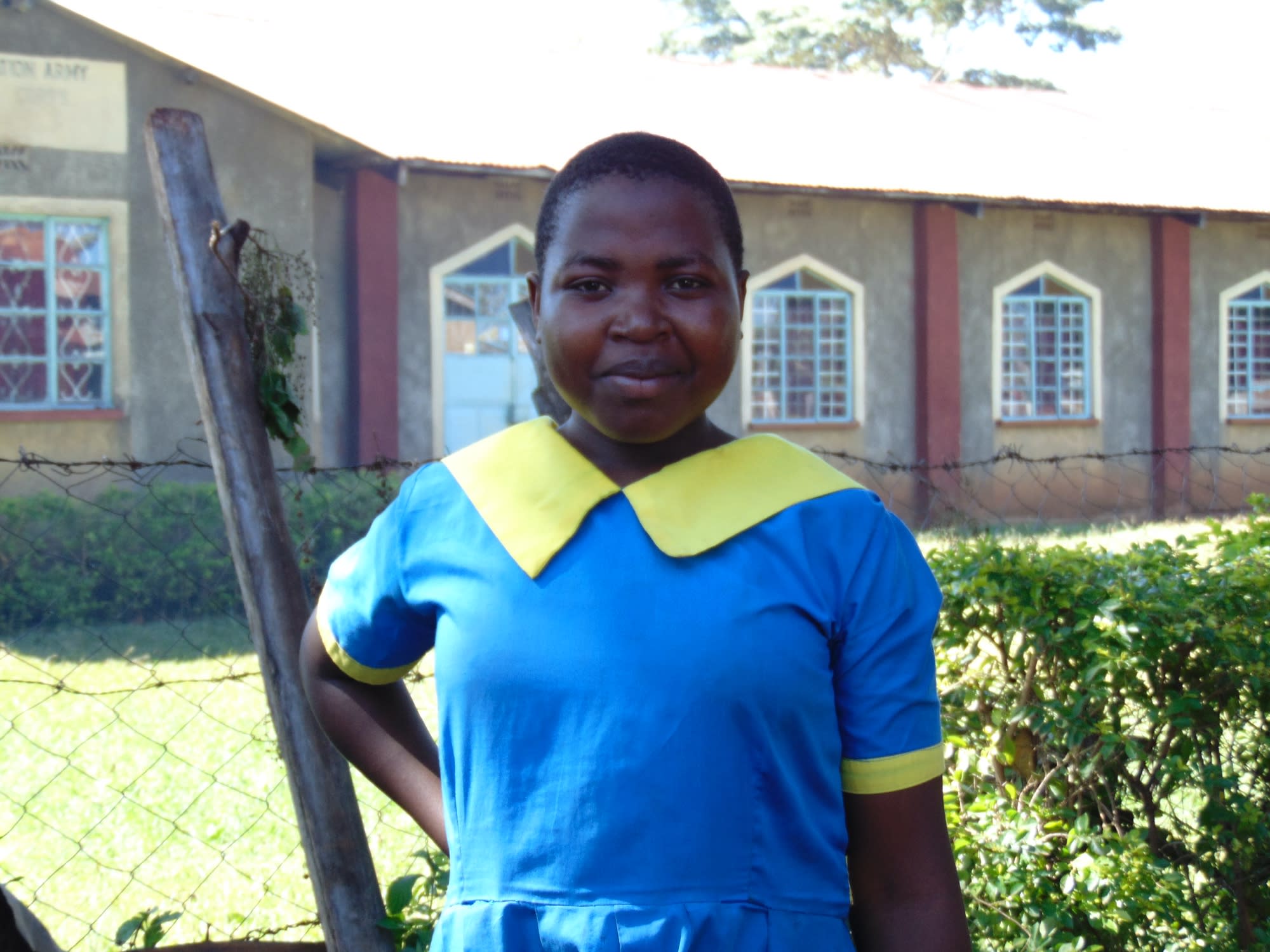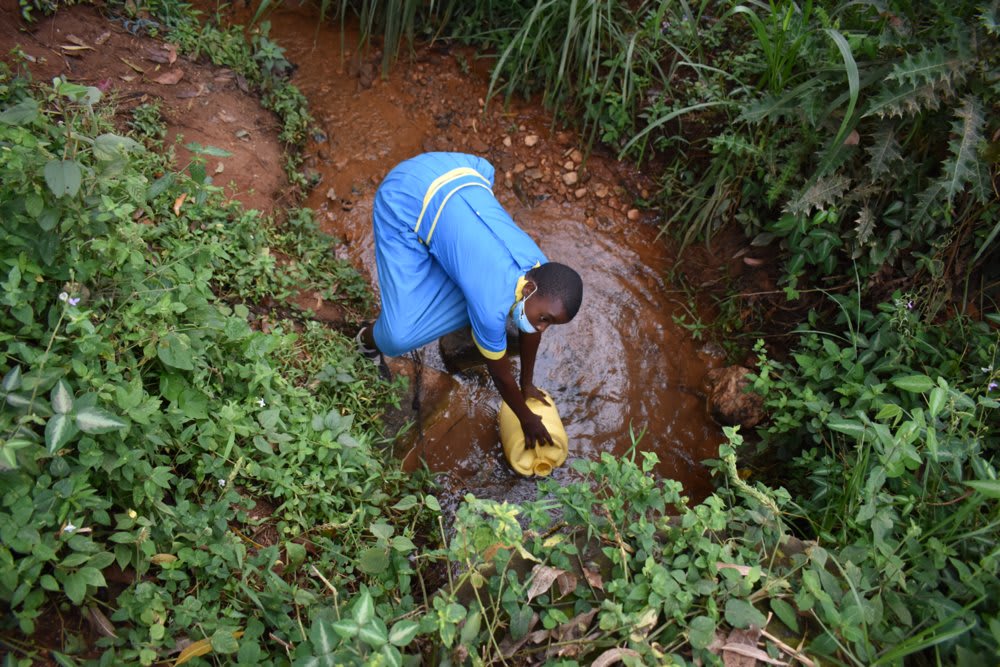(Some photos pre-date the pandemic.)
"Being a student in this school, I face quite a number of challenges related to water, but this has not affected the determination I have toward my studies," said highly motivated student Ann.

"We, especially during the short breaks, are requested to go fetch water at the spring. During this engagement, we waste a lot of time at the spring due to congestion and this eats into our lessons."
Ann is one of 330 students who attend Gimomoi Primary School along with 13 teachers and staff. Though it is one of the oldest schools in the area, established in 1982 by the Salvation Army Church, Gimomoi has retained a small student body due to having no source of water on campus. Most parents have avoided admitting their students into the school for fear of their children being sent to go fetch water at a community spring or, worse, open sources such as the one below.

Students make their first daily trip to fetch water when they arrive at school at 7:00 am. Because this water is the sole source for all of the school's drinking, cooking, and cleaning needs, students are sent back out throughout the day to fetch more water. Each trip is tiring and time-consuming. Students come back to class already drained and often have trouble focusing due to their lack of energy. Their academic performance is being dragged down accordingly.
The spring students use was at one point protected, but it has not been managed well and the structure is no longer sound. Because of this, the school questions the spring water's quality but has no means of treating it. The open water sources some students choose in an effort to avoid the lines at the spring and hurry back to class are unquestionably contaminated. One is a muddy puddle with storm drain runoff found along the road to the school.
Students' containers are also quite dirty, and the staff has no way of managing students at the collection points due to their crowding. But crowding is the way students try to speed up the process and get back to class sooner, even if it means they get a little extra dirt in their containers or put their hands over their bottles' openings. The accompanying staff, therefore, cannot bring themselves to ask the students to slow down.
The water students collect is combined for use at school, so even one dirty container means everyone is at risk for contracting waterborne diseases.
"Last year, I was diagnosed with typhoid infection and this I can relate to the water I drink here in school as most of the time it is never treated. We are not able to monitor students carefully at the spring fetching water due to the congestion," said Head Teacher Mr. Geoffrey Mukutsi.
Water-related illnesses lead to high rates of absenteeism for both students and teachers, further affecting students' grades. The illnesses are expensive to treat, often forcing both the school and parents to reallocate resources that were intended for other necessities.
Students like Ann, however, are undeterred by the challenges they face due to their current water crisis. Imagine what Ann and the rest of her friends will achieve when we help remove this barrier.
What We Can Do:
Rain Tank
A 75,000-liter rainwater catchment tank will help alleviate the water crisis at this school. The school will help collect the needed construction materials such as sand, bricks, rocks, and water for mixing cement. We will complement their materials by providing an expert team of artisans, tools, hardware, and the guttering system. Once finished, this tank will begin catching rainfall that will be used by the school’s students and staff for drinking, handwashing, cooking, cleaning, and much more.
We and the school strongly believe that all of these components will work together to improve standards at this school, which will help lead to better student academic performance and will help to unlock the potential for these students to live better, healthier lives.
Handwashing Stations
There is currently nowhere for students to wash their hands after using the latrines or before eating lunch, let alone the water to do so.
The student health club will oversee the two new handwashing stations we will provide, and make sure they are kept clean and in working condition. The club leaders will fill the handwashing stations with water daily and make sure they are always supplied with a cleaning agent such as soap or ash.
VIP Latrines
There are far too few latrines for the number of students who attend this school.
Two triple-door latrine blocks will be constructed with local materials that the school will help gather. Three doors will serve the girls while the other three will serve the boys. All of these new latrines will have cement floors that are designed to be easy to use and to clean. And with a rain tank right on school property, there should be enough water to keep them clean.
Training on Health, Hygiene, COVID-19, and More
We will hold a one-day intensive training session with students, teachers, and parents. This training will cover a wide range of topics including COVID-19 symptoms, transmission routes, and prevention; personal and environmental hygiene; and the operation and maintenance of the rain tank, latrines, and handwashing stations. There will be a special emphasis on handwashing.
Our team of facilitators will use a variety of methods to train, including participatory hygiene and sanitation transformation, and asset-based community development. We will initiate a student health club, which will prepare students to lead other pupils into healthy habits at school and at home. We will also lead lectures, group discussions, and provide illustrative handouts to teach health topics and ways to promote good hygiene practices within the school including handwashing and water treatment. We will then conduct a series of follow-up trainings before transitioning to our regularly scheduled support visits throughout the year.

 Rainwater Catchment
Rainwater Catchment
 Rehabilitation Project
Rehabilitation Project







































